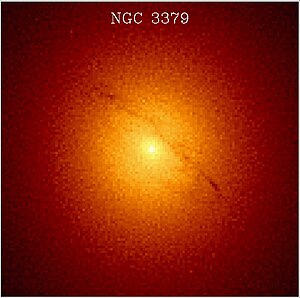Messier Index/M105
Messier 105 (also known as M105 and NGC 3379) is an w:elliptical galaxy in the w:constellation Leo. Messier 105 is known to have a w:supermassive black hole.
| Messier 105 | |
|---|---|
 | |
| Observation data (w:J2000 epoch) | |
| Constellation | Leo |
| Right ascension | 10h 47m 49.6s[1] |
| Declination | +12° 34′ 54″[1] |
| Redshift | 911 ± 2 km/s[1] |
| Distance | 32.0 ± 1.6 Mly (9.8 ± 0.5 Mpc)[2] |
| Type | E1[1] |
| Apparent dimensions (V) | 5′.4 × 4′.8[1] |
| Apparent magnitude (V) | 10.2[1] |
| Other designations | |
| NGC 3379,[1] UGC 5902,[1] PGC 32256[1] | |
History
Messier 105 was discovered by w:Pierre Méchain on 24 March w:1781, just a few days after he discovered the nearby galaxies w:Messier 95 and w:Messier 96.[3] This galaxy is one of several that were not originally included in the original w:Messier Catalogue compiled by w:Charles Messier. Messier 105 was included in the catalog only when w:Helen S. Hogg found a letter by Méchain describing Messier 105 and when the object described by Méchain was identified as a galaxy previously named NGC 3379.[3]
Galaxy group information
Messier 105 is one of several galaxies within the w:M96 Group, a w:group of galaxies in the w:constellation Leo. The group also includes the w:Messier objects M95 and M96.[4][5][6][7]
External links
References
- ↑ a b c d e f g h i "NASA/IPAC Extragalactic Database". Results for M105. Retrieved 2006-11-16.
- ↑ Jensen, Joseph B.; Tonry, John L.; Barris, Brian J.; Thompson, Rodger I.; Liu, Michael C.; Rieke, Marcia J.; Ajhar, Edward A.; Blakeslee, John P. (2003). "Measuring Distances and Probing the Unresolved Stellar Populations of Galaxies Using Infrared Surface Brightness Fluctuations". Astrophysical Journal. 583 (2): 712–726. doi:10.1086/345430.
{{cite journal}}: Unknown parameter|month=ignored (help)CS1 maint: multiple names: authors list (link) - ↑ a b K. G. Jones (1991). Messier's Nebulae and Star Clusters (2nd ed.). Cambridge: Cambridge University Press. ISBN 0-521-37079-5.
- ↑ R. B. Tully (1988). Nearby Galaxies Catalog. Cambridge: Cambridge University Press. ISBN 0-521-35299-1.
- ↑ P. Fouque, E. Gourgoulhon, P. Chamaraux, G. Paturel (1992). "Groups of galaxies within 80 Mpc. II - The catalogue of groups and group members". Astronomy and Astrophysics Supplement. 93: 211–233.
{{cite journal}}: CS1 maint: multiple names: authors list (link) - ↑ A. Garcia (1993). "General study of group membership. II - Determination of nearby groups". Astronomy and Astrophysics Supplement. 100: 47–90.
- ↑ G. Giuricin, C. Marinoni, L. Ceriani, A. Pisani (2000). "Nearby Optical Galaxies: Selection of the Sample and Identification of Groups". Astrophysical Journal. 543: 178–194. doi:10.1086/317070.
{{cite journal}}: CS1 maint: multiple names: authors list (link)